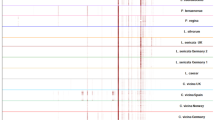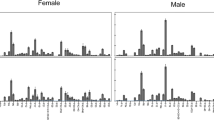Abstract
The quantity of cuticular hydrocarbons is higher in solitarious nymphs of the desert locust, Schistocerca gregaria, compared to gregarious nymphs, but the total hydrocarbon fraction of solitarious nymphs does not significantly divert behavioral transition of isolated nymphs to the gregarious phase, while gregarious hydrocarbon extracts do. This suggests that qualitative differences in composition are responsible for the biological effect. The profile of cuticular hydrocarbon components is similar in the two phases, but some peak ratios differ. Crowding of solitarious nymphs leads to rapid changes in the profile of the hydrocarbon fraction, suggesting that specific hydrocarbons are produced and secreted as a consequence. Isolating previously crowded nymphs has an opposite effect. The composition of cuticular hydrocarbons from the migratory locust, Locusta migratoria, which differs considerably from that of S. gregaria, does not induce the gregarious behavioral phase in solitarious nymphs of the latter.
Similar content being viewed by others
REFERENCES
Blomquist, G. J., Tillman-Wall, J. A., Guo, L., Quilici, D. R., Gu, P., and Schal, C. 1993. Hydrocarbons and hydrocarbon derived sex pheromones in insects: biochemistry and endocrine regulation, pp. 317–351, in D. W. Stanley-Samuelson and D. R. Nelson (eds.). Insect Lipids: Biochemistry and Biology. University of Nebraska Press, Lincoln.
Cobb, M., and Jallon, J. M. 1990. Pheromones, mate recognition and courtship stimulation in the Drosophila melanogaster species sub-group. Anim. Behav. 39:1058–1067.
Diehl, P. A. 1975. Synthesis and release of hydrocarbons by the oenocytes of the desert locust Schistocerca gregaria. J. Insect Physiol. 21:1237–1246.
Ellis, P. E. 1962. The behaviour of locusts in relation to phases and species. Colloq. Int. CNRS 114:123–143.
Ellis, P. E. 1963. The influence of some environmental factors on learning and aggregation in locust hoppers. Anim. Behav. 11:142–151.
Fuzeau-Braesch, E., Genin, E., Jullien, R., Knowles, E., and Papin, C. 1988. Composition and role of volatile substances in the atmosphere surrounding two gregarious locusts, Locusta migratoria and Schistocerca gregaria. J. Chem. Ecol. 14:1023–1033.
Genin, E., Jullien, R., Perez, F., and Fuzeau-Braesch, S. 1986. Cuticular hydrocarbons of gregarious and solitary locusts Locusta migratoria cinerascens. J. Chem. Ecol. 12:1213–1238.
Gilby, A. R. 1980. Chemical methods (lipids), pp. 217–252, in T. A. Miller (ed.). Cuticle Techniques in Arthropods. Springer-Verlag, New York.
Gillett, S. D. 1968. Airborne factor affecting the grouping behaviour of locusts. Nature 218:782–783.
Gillett, S. D. 1975. Changes in the social behaviour of the desert locust, Schistocerca gregaria, in response to the gregarizing pheromone. Anim. Behav. 23:494–503.
Gillett, S. D. 1988. Solitarization in the desert locust, Schistocerca gregaria (Forskål) (Orthoptera: Acrididae). Bull. Entomol. Res. 78:623–631.
Gillett, S. D., and Phillips, M. 1977. Feces as a source of a locust gregarisation stimulus. Effects on social aggregation and on cuticular color of nymphs of the desert locust, Schistocerca gregaria (Forskål). Acrida 6:279–286.
Hadley, N. F. 1981. Cuticular lipids of terrestrial plants and arthropods: A comparison of their structure, composition, and waterproofing function. Biol. Rev. 56:23–47.
Heifetz, Y., and Applebaum, S. W. 1995. Density-dependent physiological phase in non-migratory grasshopper, Aiolopus thalassinus thalassinus. Entomol. Exp. Appl. 77:251–262.
Heifetz, Y., Voet, H., and Applebaum, S. W. 1996. Factors affecting behavioural phase transition in the desert locust, Schistocerca gregaria (Forskål) (Orthoptera: Acrididae). J. Chem. Ecol. 22:1717–1734.
Heifetz, Y., Boekhoff, I., Breer, H., and Applebaum, S. W. 1997. Cuticular hydrocarbons control behavioural phase transition in Schistocerca gregaria nymphs and elicit biochemical responses in antennae. Insect Biochem. Mol. Biol. 27:563–568.
Jackson, L. L. 1981. Cuticular lipids of insects. IX. Surface lipids of the grasshoppers Melanophus bivittatus, Melanoplus femurrubrum, and Melanoplus dawsoni. Comp. Biochem. Physiol. 70B:441–445.
Jackson, L. L. 1982. Cuticular lipids of insects. X. Normal and branched alkanes from the surface of the grasshopper Schistocerca americana. Comp. Biochem. Physiol. 71B:739–742.
McCarthy, E. D., Han, J., and Calvin, M. 1968. Hydrogen atom transfer in mass spectrometric fragmentation patterns of saturated aliphatic hydrocarbons. Anal. Chem. 40:1475–1480.
Nelson, D. R. 1993. Methyl-branched lipids in insects, pp. 271–315, in D. W. Stanley-Samuelson and D. R. Nelson (eds.). Insect Lipids: Chemistry, Biochemistry and Biology, University of Nebraska Press, Lincoln.
Nelson, D. R., and Sukkestad, D. R. 1975. Normal and branched alkanes from cast skins of grasshopper Schistocerca vaga (Scudder). J. Lipid Res. 16:12–18.
Nelson, D. R., Sukkestad, D. R., and Zaylskie, R. G. 1972. Mass spectra of methyl-branched hydrocarbons from eggs of the tobacco hornworm. J. Lipid Res. 13:413–421.
Nelson, D. R., Nunn, N. J., and Jackson, L. L. 1984. Re-analysis of the methylalkanes of the grasshoppers, Melanoplus differentialis, M. packardi, and M. sanguinipes. Insect Biochem. 14:677–683.
Obeng-Ofori, D., Torto, B., and Hassanali, A. 1993. Evidence for mediation of two releaser pheromones in the aggregation behavior of the gregarious desert locust, Schistocerca gregaria (Forskål) (Orthoptera: Acrididae). J. Chem. Ecol. 19:1665–1676.
Obeng-Ofori, D., Torto, B., Njagi, P. G. N., Hassanali, A., and Amiani, H. 1994. Fecal volatiles as part of the aggregation pheromone complex of the desert locust, Schistocerca gregaria (Forskål) (Orthoptera: Acrididae). J. Chem. Ecol. 20:2077–2087.
Pho, D. B., Pennanec, H-M., and Jallon, J. M. 1996. Purification of adult Drosophila melanogaster lipophorin and its role in hydrocarbon transport. Arch. Insect Biochem. Physiol. 31:289–303.
Rainey, R. C. 1962. Some effects of environmental factors on movements and phase-change of locust populations in the field. Colloq. Int. CNRS 114:175–199.
Rainey, R. C. 1989. Migration and Meteorology. Clarendon Press, Oxford, 314 pp.
Roessingh, P., and Simpson, S. J. 1994. The time-course of behavioural phase change in nymphs of the desert locust, Schistocerca gregaria. Phsyiol. Entomol. 2:293–300.
SAS. 1992. Version 6.04. SAS Institute Inc., Campus Drive, Cary, North Carolina.
Soliday, C. L., Blomquist, G. J., and Jackson, L. L. 1974. Cuticular lipids of insects. VI. Cuticular lipids of the grasshoppers Melanoplus differentialis and Melanoplus packardi. J. Lipid Res. 15:399–405.
Strong, V. 1971. Gland like cells in the epidermis of desert locust. Anti-Locust Bull. 36:212–222.
Toolson, E. C., Markow, T. A., Jackson, L. L., and Howard, R. W. 1990. Epicuticular hydrocarbon composition of wild and laboratory-reared Drosophila majavensis Patterson and Crow (Diptera: Drosophilidae). Ann. Entomol. Soc. Am. 83:1165–1176.
Torto, B., Obeng-Ofori, D., Njagi, P. G. N., Hassanali, A., and Amiani, H. 1994. Aggregation pheromone system of adult gregarious desert locust Schistocerca gregaria (Forskål). J. Chem. Ecol. 20:1749–1762.
Trabalon, M., Bagneres, A. G., Hartmann, N., and Vallet, A. M. 1996. Changes in cuticular compounds composition during the gregarious period and after dispersal of the young in Tegenaria atrica (Araneae, Agelenidae). Insect Biochem. Mol. Biol. 26:77–84.
Uebel, E. C., Sonnet, P. E., and Miller, R. W. 1976. Housefly sex pheromone: Enhancement of mating strike activity by combination of (Z)-9-tricosene with branched saturated hydrocarbons. J. Econ. Entomol. 5:905–908.
Uvarov, B. P. 1966. Grasshoppers and Locusts, A Handbook of General Acridology, Vol. 1. Cambridge, at the University Press, London, 481 pp.
Author information
Authors and Affiliations
Rights and permissions
About this article
Cite this article
Heifetz, Y., Miloslavski, I., Aizenshtat, Z. et al. Cuticular Surface Hydrocarbons of Desert Locust Nymphs, Schistocerca gregaria, and Their Effect on Phase Behavior. J Chem Ecol 24, 1033–1047 (1998). https://doi.org/10.1023/A:1022302519373
Issue Date:
DOI: https://doi.org/10.1023/A:1022302519373




